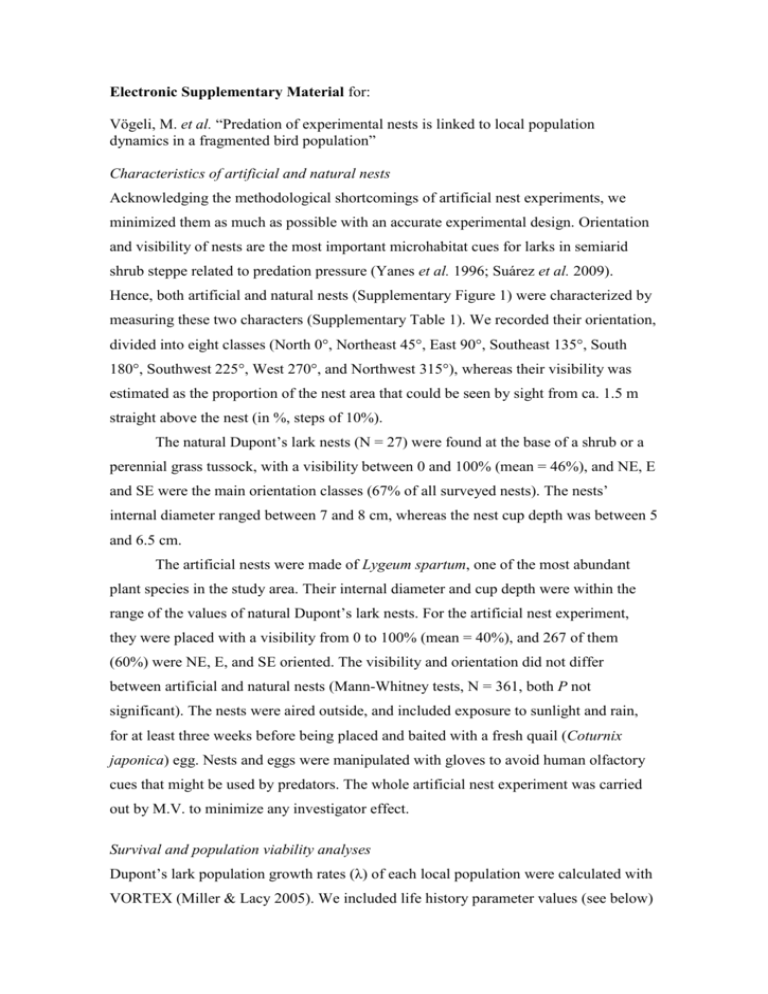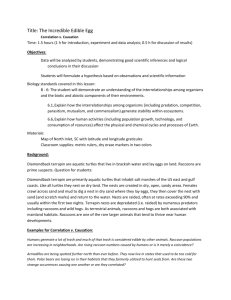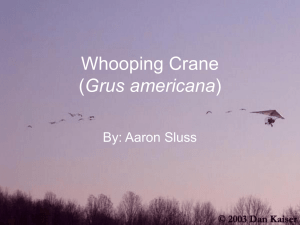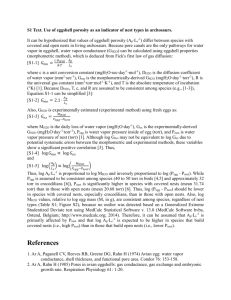Electronic Supplementary Material
advertisement

Electronic Supplementary Material for: Vögeli, M. et al. “Predation of experimental nests is linked to local population dynamics in a fragmented bird population” Characteristics of artificial and natural nests Acknowledging the methodological shortcomings of artificial nest experiments, we minimized them as much as possible with an accurate experimental design. Orientation and visibility of nests are the most important microhabitat cues for larks in semiarid shrub steppe related to predation pressure (Yanes et al. 1996; Suárez et al. 2009). Hence, both artificial and natural nests (Supplementary Figure 1) were characterized by measuring these two characters (Supplementary Table 1). We recorded their orientation, divided into eight classes (North 0°, Northeast 45°, East 90°, Southeast 135°, South 180°, Southwest 225°, West 270°, and Northwest 315°), whereas their visibility was estimated as the proportion of the nest area that could be seen by sight from ca. 1.5 m straight above the nest (in %, steps of 10%). The natural Dupont’s lark nests (N = 27) were found at the base of a shrub or a perennial grass tussock, with a visibility between 0 and 100% (mean = 46%), and NE, E and SE were the main orientation classes (67% of all surveyed nests). The nests’ internal diameter ranged between 7 and 8 cm, whereas the nest cup depth was between 5 and 6.5 cm. The artificial nests were made of Lygeum spartum, one of the most abundant plant species in the study area. Their internal diameter and cup depth were within the range of the values of natural Dupont’s lark nests. For the artificial nest experiment, they were placed with a visibility from 0 to 100% (mean = 40%), and 267 of them (60%) were NE, E, and SE oriented. The visibility and orientation did not differ between artificial and natural nests (Mann-Whitney tests, N = 361, both P not significant). The nests were aired outside, and included exposure to sunlight and rain, for at least three weeks before being placed and baited with a fresh quail (Coturnix japonica) egg. Nests and eggs were manipulated with gloves to avoid human olfactory cues that might be used by predators. The whole artificial nest experiment was carried out by M.V. to minimize any investigator effect. Survival and population viability analyses Dupont’s lark population growth rates (λ) of each local population were calculated with VORTEX (Miller & Lacy 2005). We included life history parameter values (see below) derived directly from each local population, acknowledging its spatial context as described in Laiolo et al. (2008). Very conservative simulations were set up, supposing no catastrophes nor inbreeding depression occurring, and all males reproducing. We run simulations 100 times with a time frame of 100 years, whereas extinction was defined as only one sex remaining in the population. Apparent survival probabilities were estimated with MARK 4.3 (White & Burnham 1999), based on acoustic mark-recapture data of 208 male individuals (see Vögeli et al. 2008 for more details). We started the survival analysis from the fully time dependent Cormack-Jolly-Seber model for open populations (Lebreton et al. 1992), where apparent survival () and reencounter probabilities (p) were time-specific for each population size (classes of <10, 10-30, >30 occupied territories). After testing the goodness of fit of this global model with U-CARE 2.3.2 (Choquet et al. 2009; global test, one-tailed directional test for transience, and signed test for trap-dependence: all P > 0.05), we implemented constant and time dependent model structures in MARK. The survival estimate of the most parsimonious model using the Akaike’s Information Criterion corrected by sample size (AICc) for model selection (Burnham & Anderson 2002) did not vary among population size classes (=0.46 ± 0.08SE). Hence, we employed identical mortality rates (54%) for all local populations. The Dupont’s lark is monogamous, both sexes breed from the first year on, and we set the maximum age of reproduction of 15 years with 10 offspring as a maximum number of progeny and a 50:50 birth sex-ratio (Cramp 1988). When measuring reproductive success is difficult and invasive, as it is the case of the secretive and imperilled Dupont’s Lark (Laiolo & Tella 2006), the yearling to adult male ratio is usually used as a surrogate of productivity (Vaughan et al. 2005; De Leo et al. 2007). The territorial calls of Dupont’s lark yearlings can be distinguished during summer and early autumn from those of adults by the presence of quavering harmonics, and relatively amorphous notes revealed by spectrograms (Laiolo & Tella 2005; Laiolo et al. 2007; Laiolo et al. 2008). The call learning process in Dupont’s lark yearlings lasts approximately 30 days, and leads to a gradual improvement of their call quality. Hence, we quantified the relative proportion of yearlings calling in the whole population of vocalizing males in the summer-autumn period, and thus obtained an estimate of yearling to adult male ratio (Laiolo & Tella 2007; Laiolo et al. 2008). We assumed all recorded yearlings to be born in the same local population. Only very few immigration events were effectively detected, and discarded since we were able to identify males uttering a territorial call typical of a different local population (Laiolo & Tella 2007). Eventually, these proportions were used to adjust the maximum, theoretic productivity values: Productivity was calculated as twice the species’ average clutch size (2.76 eggs per clutch, two clutches per breeding season are laid; Cramp 1988) corrected by the proportion of juveniles to adults detected over three consecutive breeding seasons (20042006) in each local population. Given the poor information available on breeding success of this species (Cramp 1988), we built different scenarios varying the percentages of successful breeding females with 10%-steps from 40 to 100%. Dispersal probabilities were set at 10% among populations separated by less than 20 km (Vögeli et al. 2010). The initial size of local populations was determined by mapping of male territories (Vögeli et al. 2010), and the carrying capacity was obtained by multiplying the maximum density observed in the metapopulation (4.8 territories/10ha) with the respective size of the local populations (Vögeli et al. 2010). We used λ to characterize population viability as it covaried with other population viability indices, such as the exponential rate of increase, the median extinction time and the mean extinction time (r > 0.53, all P < 0.05). We employed in subsequent analyses the average annual rate of population change λ calculated in the seven different simulation scenarios (from 40 to 100% females breeding successfully). References Burnham, K.P. & Anderson, D.R. 2002 Model Selection and Multimodel Inference. A Practical Information-Theoretic Approach. 2nd edition. Springer, New York Choquet, R., Lebreton, J.D., Gimenez, O., Reboulet, A.M. & Pradel, R. (2009). UCARE: Utilities for performing goodness of fit tests and manipulating CaptureRecapture data. Ecography 32, 1071-1074 Cramp, S. 1988 The Birds of the Western Palearctic. Vol. 5. Oxford Univ. Press, New York De Leo, G.A., Focardi, S., Gatto, M. & Cattadori, I.M. 2004 The decline of the grey partridge in Europe: comparing demographies in traditional and modern agricultural landscapes. Ecol. Model. 177, 313-335 Laiolo, P. & Tella, J.L. 2005 Habitat fragmentation affects culture transmission: patterns of song matching in Dupont’s lark. J. Appl. Ecol. 42, 1183-1193 Laiolo, P. & Tella, J.L. 2006 Landscape bioacoustics allows detection of the effects of habitat patchiness on population structure. Ecology 87, 1203-1214 Laiolo, P. & Tella, J.L. 2007 Erosion of animal cultures in fragmented landscapes. Front. Ecol. Environ. 5, 68-72 Laiolo, P., Vögeli, M., Serrano, D. & Tella, J.L. 2007 Testing acoustic versus physical marking: two complementary methods for individual-based monitoring of elusive species. J. Avian Biol. 38, 672-681 Laiolo, P., Vögeli, M., Serrano, D. & Tella, J.L 2008 Song Diversity predicts the viability of fragmented bird populations. PLoS ONE 3, e1822 Lebreton, J.D., Burnham, K.P., Clobert, J. & Anderson, D.R. 1992 Modelling survival and testing biological hypothesis using marked animals: a unified approach with case studies. Ecol. Monogr. 62, 67-118 Miller P.S. & Lacy, R.C. 2005 VORTEX: a Stochastic Simulation of the Extinction Process, Version 9.50 Suárez, F., Hervás, I. & Herranz, J.M. 2009 Las alondras de España peninsular. Organismo Autónomo Parques Nacionales, Madrid, Spain Vaughan, C., Nemeth, N.M., Cary, J. & Temple, S. 2005 Response of a Scarlet Macaw Ara macao population to conservation practices in Costa Rica. Bird Conserv. Int. 15, 119-130 Vögeli, M., Laiolo, P., Serrano, D. & Tella, J.L. 2008 Who are we sampling? Apparent survival differs between methods in a secretive species. Oikos 117, 1816-1823 Vögeli, M., Serrano, D., Pacios, F. & Tella, J.L. 2010 The relative importance of patch habitat quality and landscape attributes on a declining steppe-bird metapopulation. Biol. Conserv. 143, 1057-1067 White, G.C. & Burnham, K.P. 1999 Program MARK: survival estimation from populations of marked animals. Bird Study 46, 120-139 Yanes, M., Herranz, J. & Suárez, F. 1996 Nest microhabitat selection in larks from a European semi-arid shrub-steppe: the role of sunlight and predation. J. Arid Environ. 32, 469-478 Supplementary Figure 1. In situ comparison of a natural Dupont’s lark nesting site (A.1) and nest (A.2) with a nesting site (B.1) and nest (B.2) employed in the artificial nest experiment. Supplementary Table 1. Characteristics of the nests employed for the artificial nest experiment and the natural Dupont’s lark nests found in our study area. Population Sample size Orientation (in degrees) Visibility (in percents) Min. 0 90 0 0 90 0 0 0 0 0 0 90 0 0 45 45 Max. 270 135 315 315 225 270 315 270 315 315 270 270 315 225 270 315 Mean 33 34 46 42 35 43 35 30 35 30 36 45 39 43 38 53 Min. 0 0 0 0 10 0 0 0 0 0 0 20 0 20 10 20 Max. 80 70 90 90 80 90 80 70 80 60 100 90 90 70 70 90 0 315 46 0 100 1 2 3 4 5 6 7 8 9 10 11 12 13 14 15 16 30 6 42 24 18 29 36 12 23 18 12 6 48 6 12 12 Mean 138 120 113 118 145 144 181 116 106 162 116 158 121 128 135 173 Natural nests 27 108 Supplementary Table 2. Detailed characteristics – including population growth rates (λ) – of the 16 local populations where artificial nest predation experiments were conducted (circled patches in Fig. 1). The information on nests set out/predated refers to the artificial nests used for the experiment. Population 1 2 3 4 5 6 7 8 9 10 11 12 13 14 15 16 Total Territories 25 6 40 50 12 30 42 2 30 7 6 5 36 7 2 2 302 Size (ha) 158.7 38.2 510.1 771.6 260.8 240.0 486.4 27.0 126.7 42.1 19.4 23.4 370.2 14.6 20.8 46.6 3156.6 λ 0.95 0.90 1.03 0.95 0.64 0.86 0.90 0.63 0.95 0.68 0.98 0.97 1.07 0.73 0.00 0.00 Nests set out 30 6 42 24 18 29 36 12 23 18 12 6 48 6 12 12 334 Nests predated 20 3 36 10 15 24 15 7 4 5 4 3 26 5 7 12 196 % 66.7 50.0 85.7 41.7 83.3 82.8 41.7 58.3 17.4 27.8 33.3 50.0 54.2 83.3 58.3 100.0 58.7







